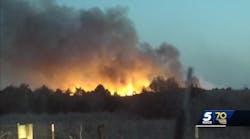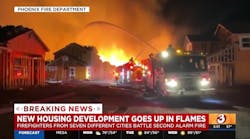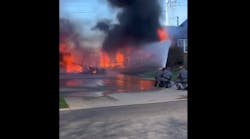NEW HARMONY, Utah (AP) -- Tim and Cindy Reeder landscaped their home with grass, trees, shrubs, wild flowers and a rock garden.
After their night spent in a motel getting conflicting information on whether a wildfire had destroyed their home, they returned to find the trees blackened but the grass and wildflowers untouched.
''It looks like something from a Frankenstein movie,'' Tim Reeder said Tuesday.
Some of the vinyl siding on their home at buckled, causing about $500 damage.
That was the only damage reported to any of the homes evacuated late Monday in the Harmony Heights development just south of New Harmony.
On their home, the Reeders found a note from firefighters saying the landscaping had left them the room and ability to ''save your property.''
Hundreds of people evacuated Monday night when the winds suddenly shifted and pushed the 12,000-acre Blue Springs Fire into the New Harmony area. The flames actually came within the Harmony Heights development before the winds died down.
From television broadcasts of the fire scene, it appeared some homes must have been lost.
Indeed, the Reeders, at their motel room in Cedar City, got a call from a friend in Arizona, who ''saw it on TV and saw our house and said, 'Your house is toast,''' Tim Reeder said.
However, the next call was from Cindy Reeder's boss, a Utah Highway Patrol lieutenant, who said, ''Guess where I am? ... I'm in your kitchen. Your house is fine.''
For years, officials have urged residents in fire-prone areas to landscape with wildfires in mind.
In the New Harmony area, many heeded that call on Sunday as the fire burned toward their community.
Jack Reed spent that day creating a 4,000-square foot perimeter around his Harmony Heights home. He cut down trees, cut back branches and bought sprinklers and hose.
Then on Monday, he and friends rigged the sprinklers on the roof and left them running when they evacuated.
''When we left here, there was a wall of fire at the end of the neighborhood. I've never seen or heard anything like it,'' said his wife, Linda Reed. ''It was obviously very, very scary.''
She said they ''were amazingly lucky'' to find their home intact Tuesday. ''It's a big destruction to your life. And, of course, it's very scary when you think it's all going to go up in smoke.''
Fire officials said the Blue Springs Fire, about 20 miles north of St. George, was about 50 percent contained by late Tuesday.
Elsewhere in southwestern Utah, the state's largest wildfire, the 68,264-acre Westside Complex fire, was declared contained late Tuesday.
Meanwhile, lightning started two new fires Tuesday morning and six more in the afternoon.
The biggest were the 2,800-acre Plateau Fire, which burned close to farm buildings just four miles north of St. George, and the 4,300-acre Diamond Valley Fire, which was burning near the community of Diamond Valley 10 miles north of St. George.
Although those two fires were burning near buildings, no homes were believed in immediate danger.
The National Interagency Fire Center in Boise, Idaho, said Tuesday that 21 large fires had burned more than 769,000 acres in Alaska, Arizona, California, Idaho, Nevada, New Mexico and Utah.
In Nevada, a 33,500-acre wildfire that had blanketed Las Vegas with smoke and prompted the evacuation of a Boy Scout camp was nearing containment. But elsewhere in the southern part of the state, firefighters dug in as a buffer narrowed to 10 miles between a railroad town and two big fires in an uninhabited area that is home to desert tortoises.
Hundreds of firefighters worked to stem flames in mountains south of Caliente, while others protected a Union Pacific Railroad line through Meadow Valley, 50 miles north of Las Vegas.
David Chevalier, a U.S. Forest Service spokesman, could not provide acreage figures but said not all the area within the rugged and remote 628-square-mile fire zone was burned.
''It's sporadic,'' he said. ''It burns in irregular patterns.''
Some firefighters reported seeing federally protected desert tortoises that survived flames sweeping across cheatgrass, sage, mesquite and Joshua trees, Chevalier said.
Arizona's biggest blaze, about 30 miles north of Phoenix, grew to 140,000 acres by Tuesday night and was expected to keep spreading. The lightning-sparked fire had been 25 percent contained but breezy conditions Tuesday caused the fire to grow significantly. It was back to 20 percent contained, fire officials said.
There were no reports of damage.
On the Net:
National Interagency Fire Center: www.nifc.gov





